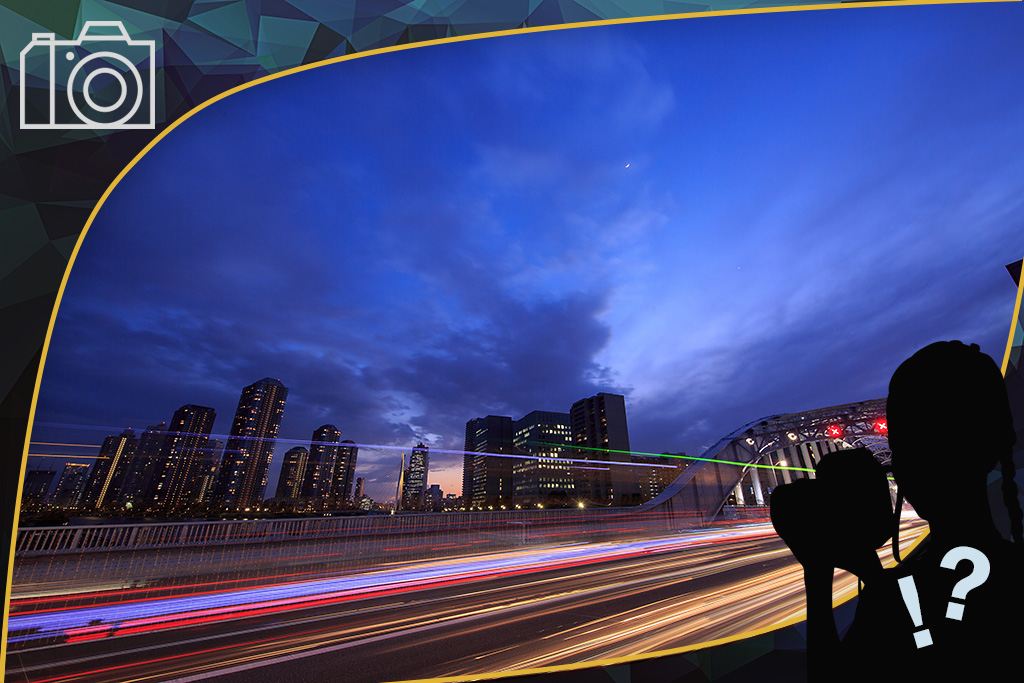Camera FAQ #10: What is the optimal shutter speed for shooting nightscapes?
Your selection of shutter speed is critical to capturing beautiful nightscapes. In this article, I will explain how to determine the optimal shutter speed, using photos of a glittering city nightscape, vehicle light trails, and reflected glare on a water surface as examples. (Photo & text by: Kazuo Nakahara)

POINT 1: When shooting city nightscapes, pay more attention to the f-number than the shutter speed
POINT 2: Use a long exposure to beautifully capture the light from light trails and reflections
While camera performance has improved nowadays to the extent that you can even capture nightscapes during handheld photography, you might want to consider a more professional approach using a tripod.
In a nightscape shoot, there are endless point light sources in the darkness, so your selection of the shutter speed becomes critical. When shooting regular city nightscapes though, you should make relatively still objects such as buildings the subject. In doing so, you can focus more on finding the appropriate f-number than on adjusting the shutter speed to bring out starbursts in your photos. There is no need to set an excessively slow shutter speed as this can also cause blurring. Set an ISO speed that gives a picture quality acceptable for what you want to express, with a shutter speed of around 1 to 5 seconds as a guideline.
On the other hand, when capturing car lights as light trails, a shutter speed of 10 to 20 seconds should be sufficient in most cases where there is relatively heavy traffic. However, when shooting at a time when there is little traffic on the road, such as in the middle of the night, you may need to use an ND filter or similar and set an exposure time of 60 seconds or longer.
Furthermore, when you want to express a silky effect for moving water surfaces, a short shutter time can make the surface of the water appear mottled. At such times, you might want to try a longer shutter time of around 30 seconds. This also lets you properly bring out the colour of the light reflected off the water.
SCENE 1: City nightscape - 1 second

EOS 5D Mark III/ EF24-105mm f/4L IS USM/ FL: 50mm/ Aperture Priority AE (f/8, 1 sec., 1 sec., EV-0.7)/ ISO 200/ WB: 4,500K
Because I used a long exposure, there was a possibility of blurring due to the continuous movement of the Ferris wheel. This was why I decided to shoot using the shortest possible shutter speed. With this lens I was able to get the most out of the resolution, adjusting the ISO speed to complete the shot using a short shutter speed of 1 second, after setting the aperture to f/8 so that I could capture starbursts.
SCENE 2: Vehicle light trails - 15 seconds

EOS 5D Mark III/ EF11-24mm f/4L USM/ FL: 14mm/ Aperture Priority AE (f/11, 15 sec., EV ±0)/ ISO 100/ WB: 5,600K
I watched the signal change and aimed to capture the right timing of the cars passing by. I decided the best shutter speed was 15 seconds. I captured the light trails, frozen in motion, by attaching an ND filter and keeping the aperture at f/11 to prevent any blurring that would be caused by diffraction at a narrower aperture. At the same time, I set the ISO speed to 100 to achieve suitable background brightness.
SCENE 3: Reflections on water - 60 seconds

EOS 5D Mark III/ EF16-35mm f/2.8L II USM/ FL: 24mm/ Aperture Priority AE (f/22, 60 sec., EV±0)/ ISO 50/ WB: 3,500K
The surface of rivers are often choppy, which, when a standard shutter speed is used, can prevent you from obtaining a beautiful depiction of the reflection of a nightscape. By using a long exposure time of 60 seconds or longer in Bulb mode, however, the movement of the water is evened out during exposure, allowing me to recreate a smooth and beautiful water surface that was captured distinctly.

Kazuo Nakahara
Born in Hokkaido in 1982, Nakahara turned to photography after working at a chemical manufacturing company. He majored in photography at the Vantan Design Institute and is a lecturer for photography workshops and seminars, in addition to working in commercial photography. He is also a representative of the photography information website studio9.

Digital Camera Magazine
A monthly magazine that believes that enjoyment of photography will increase the more one learns about camera functions. It delivers news on the latest cameras and features and regularly introduces various photography techniques.
Published by Impress Corporation
































